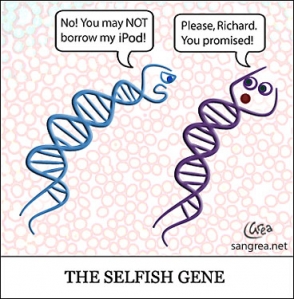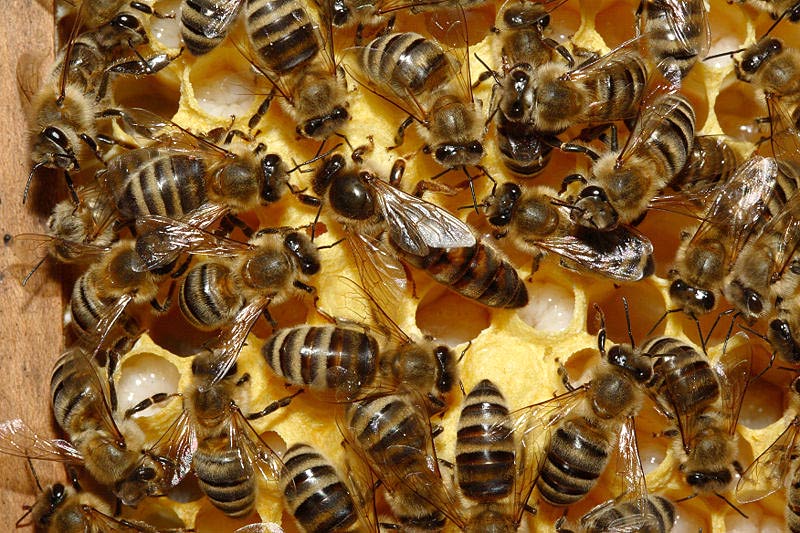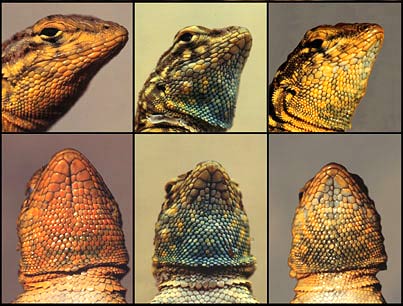

February 5, 2009
Kin selection as an explanation for the evolution of altruism seems so intuitively right that it’s hard to accept that it’s wrong, but that’s what the eminent sociobiologist E.O. Wilson—a former believer—has concluded. Plenty of other eminent scientists, such as Richard Dawkins, still disagree with him.
In the argument that kin selection drove the evolution of insect colonies, Wilson now thinks (repeat link from Part I) the math was wrong (workers expend care not only on sisters who share three-fourths of their genes, but on brothers who share only one-fourth); the assumption of mother-daughter solidarity was wrong (there’s “evidence that queens and their worker daughters are in . . . conflict,” so as some of us know all too well from our human families, “kin selection is dissolutive, at least in part, as opposed to binding”); and the facts were wrong:
[A] growing body of research has disclosed that colonies of social ants and wasps are often founded by unrelated queens; that workers do not show preference for their own mothers in multiple-queen colonies, only occasionally for their sisters; and that colonies remain well organized and stable even in the extreme cases when the workers composing them are only very distantly related or not at all.
If not kin selection, then what is driving the development of the remarkable degree of self-sacrifice in these colonies? Wilson, as his new Superorganism book with Hölldobler, and Dunn’s review of it, make clear, has become a convert to the idea of group selection in social insects, a notion (perfectly Darwinian, but fallen out of favor after 1960) long and doggedly promoted—and boldly extended to human society—by David Sloan Wilson, no relation to E.O. but the son of Sloan Wilson, who wrote The Man in the Gray Flannel Suit, ironically a portrait of 1950s conformity. You can really see the waves of cultural politics passing through science: the Selfish Gene focus on individual selection peaked, and ebbed, pretty much in sync with let-it-all-hang-out individualism! But back to the insects, and E.O.:
[T]he critical binding force of colony evolution appears to be ecological natural selection operating at the level of the colony, a level that comprises both colonies versus individuals, and colonies versus other colonies. It is theoretically possible, and may well occur in nature, that colonies evolve by the selective favoring of genes that prescribe group formation with altruistic workers in a manner that has little or nothing to do with kinship. . . . once colonies have evolved, members of the worker caste tend to be closely related to one another simply because they have common parentage.

Put another way, individuals do not form colonies because they are closely related. They are closely related because they form colonies.
In other words, groups that are altruistically organized, whether close kin or not, may out-survive and out-reproduce both loners and groups riddled with internal conflict and competition. In this model of the evolution of cooperation, it is the society, even more than the individual or the “bloodline,” that is the target of selection. Many scientists now believe there must be a continual alternation and interplay among the three: “multilevel selection.”
If the individual may not be the only target of selection, there’s now evidence—from recent studies of the annual side-blotched lizard, Uta stansburiana—that the individual gene may not be the only unit of selection, either.
This species comes in three different throat colors—orange, yellow, and blue—and throat color corresponds to different territorial behaviors in the males. Blue-throated males form partnerships in which two males cooperate to protect their territories; orange-throated males are highly aggressive and usurp territory from other lizards; and yellow-throated males sneak into the territory of other males to mate with females.
The blue throat evidently serves as a signal enabling unrelated cooperator males to recognize each other and team up. (In this lizard species young siblings squabble and disperse, so brothers are unlikely to end up as partners.) W.D. Hamilton had proposed just such a
  mechanism as a possible defense against cheating; when Richard Dawkins popularized the concept in The Selfish Gene, his playful example was men with green beards, and the name stuck. The study of the lizard blue-throats by Barry Sinervo and colleagues at the University of California, Santa Cruz, "provides the first comprehensive genetic evidence of a greenbeard in vertebrates," Sinervo says. Their behavior ranges from mutual aid to true altruism—both males benefit from the partnerships in easy times, but when orange-throated bully boys abound, one blue-throat may sacrifice his reproductive chances to defend his buddy—and Sinervo’s group has discovered that more than one gene is involved:
mechanism as a possible defense against cheating; when Richard Dawkins popularized the concept in The Selfish Gene, his playful example was men with green beards, and the name stuck. The study of the lizard blue-throats by Barry Sinervo and colleagues at the University of California, Santa Cruz, "provides the first comprehensive genetic evidence of a greenbeard in vertebrates," Sinervo says. Their behavior ranges from mutual aid to true altruism—both males benefit from the partnerships in easy times, but when orange-throated bully boys abound, one blue-throat may sacrifice his reproductive chances to defend his buddy—and Sinervo’s group has discovered that more than one gene is involved:
The greenbeard gene (or genes) must do three things: establish a signal (the green beard), enable recognition of others that share the signal, and promote cooperative behavior [or “donation”] towards other greenbeards. . . .

Sinervo’s group investigated the genetic basis of the cooperative behavior in blue-throated males. They found that, in addition to the gene that controls throat color, there are at least three other genetic factors that determine the components of the greenbeard effect.

Sinervo said. "Unlike Hamilton’s idea and most modern views of greenbeards, we find that many genetic loci across the genome ’cooperate’ to establish conditions for the greenbeard behaviors."
Sinervo’s paper is way technical—whole chunks are written in mathish, not one of my languages—but what jumps out at a layperson is “correlational selection,” the notion that natural selection may act on, and in doing so more firmly link together, a complex of interacting genes:
We have mapped key genetic factors for self-recognition of genetic similarity and a key signal locus, OBY [orange, blue, yellow]. These loci express the three traits necessary for greenbeard behavior: signal, recognition, and donation. OBY color is a component of both greenbeard donation and signal, given relations with territoriality, stamina, testosterone, and aggression. Thus, blue color is a signal for identifying other potential cooperators with similar territorial restraint, symmetry in stamina, and lower aggression relative to O males. . . .

[A]t least three other self-recognition and color-recognition factors are linked to OBY signals by correlational selection on the benefits afforded by self-recognition and cooperation. Correlational selection exists because all signal-recognition donation components are required for bb cooperation, but such alleles are harmful for other morphs like O, which have aggressive behaviors that destabilize cooperation. Hamilton did not consider the power of correlational selection in coupling suites of traits and driving coordinated evolution of the many loci required for complex behaviors like cooperation. . . . The correlational selection that bundles components for signal, self-recognition, and self-attraction plays a profound role in building the genome-wide bluebeard of Uta. Correlational selection on recognition systems should be general for all forms of evolutionary cooperation.

Even in kin altruism, sharing a fraction of genes is not sufficient for donation; specific genes that allow recognition of kin, exclude cheaters, and coordinate donations are required. A proximate explanation for kin altruism is not that kin share a fractional number of genes; rather, kin altruists share key genes for signal, self-recognition, and donation behavior.
Does any of this remotely apply to us humans, whose brains are so plastic and so much of whose behavior is learned? Anyone can observe that some families stick together and some don’t. Among the many factors that lead to one scenario or the other, some could certainly be genetic. (We’ve come a long way since E.O. Wilson’s groundbreaking Sociobiology was viciously attacked for suggesting that human behavior might have a genetic basis.) If so, it’s obviously not the case that blood kin automatically sacrifice for each other; rather, genes that may predispose some families or communities to clannishness could have been propagated by group selection, while rugged individualists are more apt to broadcast their genes the old-fashioned way—selfishly. Different levels of selection would tend to produce different and complementary kinds of fitness, visible even in the competition among societies: unlike, say, China, the United States, populated by people who dared to strike out on their own, excels in producing innovators and entrepreneurs but has trouble acting collectively. Societies need cohesion and change in some kind of balance; at one end of the scale lurks the danger of stagnation, at the other, disintegration.
It’s fascinating to learn that in side-blotched lizards, the three different kinds of fitness compete and alternate without ever wiping each other out:
Male competition drives rock–paper–scissors (RPS) cycles of three strategies: sneakers [yellow throat] beat usurpers, mate guarders [blue] defeat sneakers, and usurpers [orange] prevail over mate guarders. . . .

The lizard populations go through cycles in which one color after another increases its numbers at the expense of the others, but none are able to maintain dominance.
It’s easy to imagine, though probably impossible to prove (and here irresponsible bloggers have a carte blanche not granted to scientists), that humans come in two or three social morphs: call them tribal, trader, and... well... nerd, but technogeek keeps the alliteration going. “Tribals” would have very strong signal, recognition, and donation for “their own kind”—a point of view expressed so rationally here that it takes a while to realize you’re reading, if not a white-supremacy, at least a white-solidarity site. “Traders,” lacking those strong birds-of-a-feather cohesion drives, would be free and even impelled to cross boundaries in search of novelty and fortune—at higher risk (the guy in the pith helmet in the cartoon cannibals’ pot is definitely a Trader), but sometimes for a higher payoff. “Technogeeks,” more focused on ideas and things than on people, would just want to be left alone to tinker and invent. Ring any bells? Our ever more global world is dominated by Traders—only thanks to the Technogeeks!—but the recoil of horrified Tribals poses a genuine danger (and, perhaps, counterbalance) to the Traders having their way.
Okay, enough bloggy blather—back to the science next time.
NEXT: Game Theory, Reciprocity, and Reputation: How Social Life Builds Big Brains



(Annie Gottlieb) |
Comments (add yours!)

Return to facTotem home
|









